What to do if brown or brown spots appear on beet leaves, how to treat
It is generally accepted that the state of the tops can be used to judge the health of plants. If the leaves of the beets are stained, how to process them to save the harvest becomes the main problem of the gardener. Before choosing an effective remedy, it is important to determine exactly what caused the damage - a disease or insect pests.
How to protect the future harvest from diseases
Beet leaf diseases can manifest in different ways. White bloom, spots of gray, white, brown, yellow, red or brown color may appear on them, which eventually lead to perforation of the leaf plate and, in the future, to the death of leaves.

Sometimes, to prevent the appearance of damage, it is enough to treat seeds and root crops with Fundazol or another fungicide before planting. But, if the cause of the damage is different, this measure will not be enough.
There may be several factors that provoke the appearance of spots, dots and holes on the beet tops:
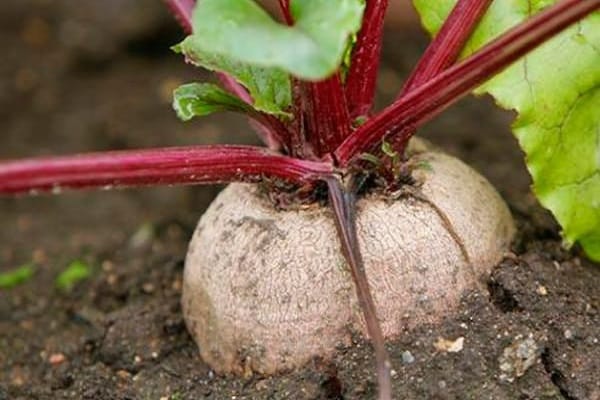
- Unsuitable soil: too acidic, waterlogged, lacking in nutrients. So, with a lack of potassium, yellow spots appear on the leaves, and with a deficiency of sodium, red ones. To eliminate mineral deficiencies, fertilizers of industrial production or organic origin are used.
- Insufficient watering, especially during the period of growing green mass. In this case, cracks appear on the sheets.
- Diseases of beet leaves of various etiologies. Most often these are fungal infections, but viral and bacterial infections occur. In this case, characteristic spots and dots appear on the leaves, the tops turn yellow and die off ahead of time. Root vegetables may not be affected externally, but storing affected vegetables can lose most of the crop.
In the latter case, it is important to timely identify the signs of beet leaf disease, correctly determine its cause and choose the appropriate treatment. To protect plants from fungal diseases, seed and root crops are treated with Fundazol (10 g per 0.5 L of water) or other fungicides.
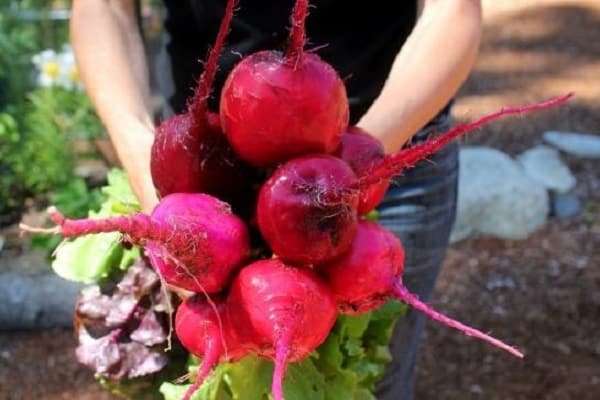
Beetroot diseases: signs and causes
Beet leaf spots can appear for a variety of reasons. Determining why the leaves have changed and have an unhealthy appearance is important in order to find the most effective method of dealing with the problem.
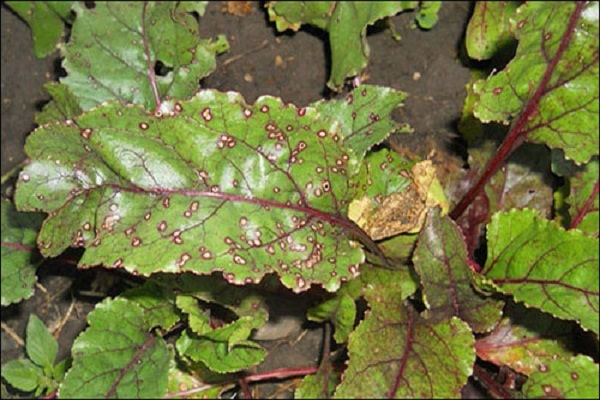
Brown spots on beets - what are they?
If in an adult, ready to harvest, the leaves of the plant change color, brownish spots cover the leaf plates, and subsequently the fruits, the cause is most likely phomosis. The spots are small at first, slightly elongated. Then they merge, dark points of spores appear on them, which fall on the fetus. The foliage withers, dries and dies off.
The root crop becomes wrinkled and rots after being stored. Dry rot starts at the bottom of the fruit and moves towards the base. On the cut, the fruit is dark, with dark gray or brown spots. Affected fruits piled up in a heap form foci of clump rot.
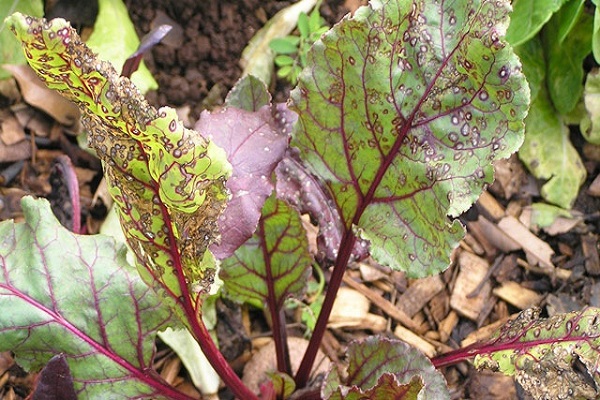
As a preventive measure, seeds are treated with Fundazol. Young shoots are treated with fungicides such as Strike or Benomil, copper preparations.
As a preventive measure, the observance of crop rotation is used (the gap between plantings of beets in one area should be at least 3 years), timely harvest, the introduction of mineral fertilizers, in particular, potassium and especially boron, the lack of which provokes the death of the growth point of the fruit and opens the gate for the pathogen phomosis.
Since the source of infection is the remnants of infected plants, they must be removed and destroyed immediately. It is best to use disease resistant varieties and hybrids.
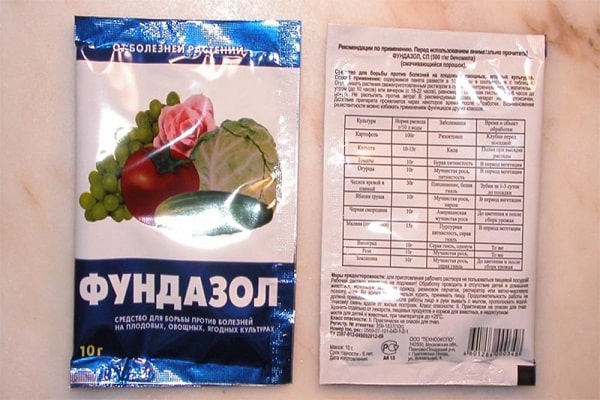
Why do young leaves of beets brighten and dry up?
The simplest reason for the appearance of light spots and drying of leaves of a culture is improper watering and feeding. If the procedure is carried out in sunny hot weather, the likelihood of burns on the sheets increases after the ingress of water drops and nutrient solutions.
But the reason that such changes appear or appear on the leaves may be mycosis - peronosporosis (downy mildew). At the same time, some leaves brighten, become covered with a gray-purple bloom on the underside, curl down, dry out and die off. First of all, the central leaves in the outlet suffer. The disease manifests itself during the period of prolonged rains and after the temperature drops below +16 ºС.
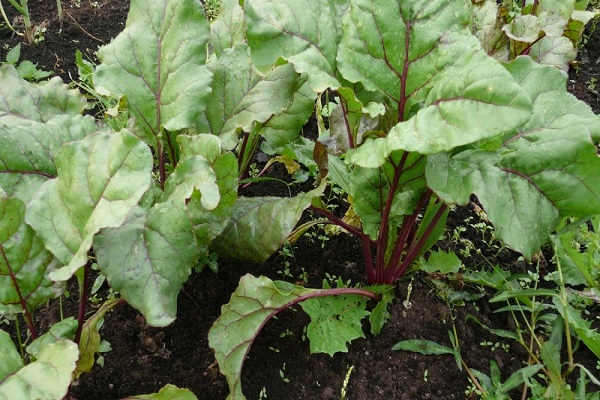
Affected shoots are treated with 1% Bordeaux liquid or 0.5% copper oxychloride solution. Spraying is carried out twice with an interval of 10 days. Before sowing, the seeds are treated with fungicides. Prevention consists in observing crop rotation, timely weeding of beet rows and removing weeds from the site.
Beet seedlings die before they grow up: what's wrong with them
Sometimes it happens that the beets, the leaves of which were the first to react to the infection, die immediately after germination or emergence. This can happen if the genetic potential of the seeds is too low, the sprouts receive insufficient moisture or there is a deficiency of nutrients in the soil, fertilizers and top dressing are not applied in time. In this case, the sprout will be weak and pale, why the beet seedlings die at an early date, there may be other reasons.
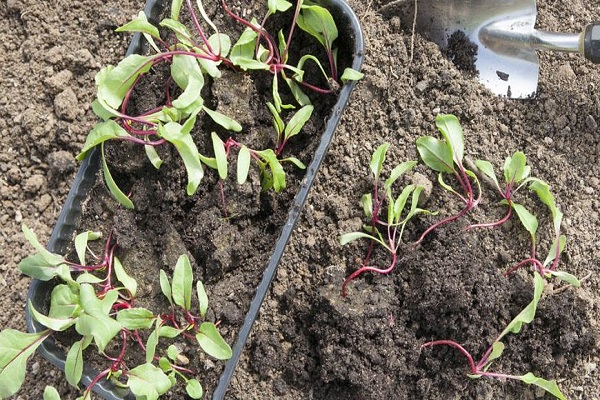
A disease such as root beetle can cause seedling death at an early stage. The cause of the disease is fungi or microorganisms. Most often, plants suffer on waterlogged, heavy, clayey soil.
Prevention consists in regularly loosening the beds, applying fertilizer and feeding.

Why are there brown spots with red edges on the leaves?
If the beet leaves are covered with brown spots with a red border, the cause is the fungal disease cercospora. Most often, the disease occurs if, after the emergence of seedlings, the maintenance of the cleanliness of the soil is not at the proper level.
Lower adult leaflets of the rosette are affected first. Initially, small brown spots appear with red edges on the front side of the leaf plate and a light gray bloom from the fungus spores from the inside. The spots turn into holes. As a result, the foliage dries, turns brown, curls, which leads to the death of it and the core of the rosette, and then the entire plant.Even if the beets have enough strength to throw out new leaves, the yield of root crops is significantly reduced.
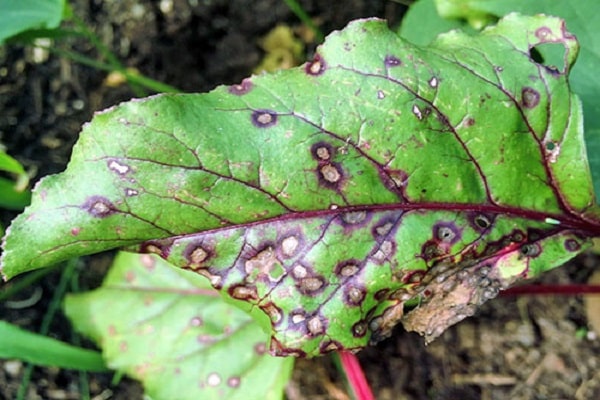
Warm and humid weather favors disease development. As a prophylaxis and treatment, fungicide treatment of seedlings and maintaining the cleanliness of the soil from weeds are used. You can use fungicides Rovtal, HOM, Propiconazole for primary treatment. Bordeaux mixture or other preparations containing copper for secondary, after 2 weeks.
Thinning of sprouts is effective after the appearance of 2-3 true leaves, removal of clean grass and dead wood.

The petioles of beet leaves turn black: what's wrong with them
The petioles of beet leaves often turn black as a result of damage to plants by fungi of the genus Pythium - Fusarium and Debarianum. This disease is called root beet root. It develops against the background of low air temperature, high acidity and moisture content of the soil, and its poor aeration. The need for effective control measures is high, since the root-eater can lead to the death of 50 to 100% of the seedlings.
Roots die, seedlings nutrition worsens. The stalk in the root part becomes thinner, rots, blackens, and as a result dies off. The root grower develops on young shoots. After the appearance of 2 pairs of true leaves, the plants acquire resistance to the disease.
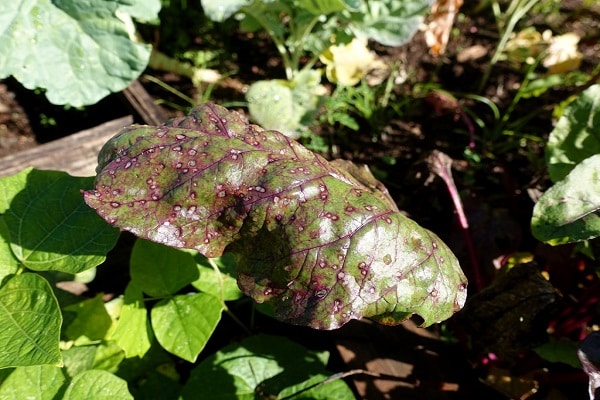
To prevent the disease, there is a need for effective control measures: in liming the soil to reduce acidity, in using seeds pretreated with fungicides, in observing crop rotation and agricultural technology, in particular, carrying out regular loosening to improve soil aeration.
Since the spores of the fungus persist in the plant litter that has not been harvested from the beds, it is necessary to promptly remove the weeds, affected plants and beet tops from the site.
Beet pest insects
Often insects are the reason that the leaves of the beet are covered with spots, what to do in this case, often depends on the type of insect. Most often, the culture is affected by the following insects:
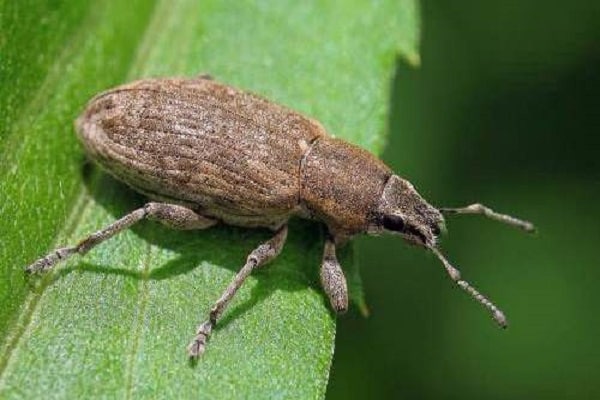
- Beet weevils. Insects are everywhere. These are gray-brown beetles 12-16 mm long. They hit the seedlings until 3 pairs of true leaves appear - they eat and bite the cuttings. The larvae eat parts of the root crop. At the same time, the tops wither prematurely, and the fruits lose their presentation.
- Aphid. They are small, up to 2.5 mm in length, black or dark green insects. They populate the underside of the leaves and eat holes in them. Damaged tops curl up and dry out, and root crops lag behind in development.
- Beet fleas - common and southern. Insects have been inhabiting the site since early spring. The size of flea beetles is up to 2.3 mm. Their body is colored dark green. Pests gnaw out the soft part of the leaf plate with spots, leaving a whole skin on the underside. Over time, these areas turn into holes. White larvae with a yellow head eat beet leaves.
- Shitonoska, or beet bug. This is one of the main crop pests. Bed bugs have a body up to 7 mm in length, rusty brown or green with black dots. The larvae are yellow-green in color. The adults eat the shoots, and the larvae eat the lower part of the leaf plates.
- Miner moth. Females lay eggs on cuttings of leaves. The larvae - caterpillars of the spring-summer generations - eat up the foliage, and of the summer-autumn ones - make moves and damage parts of the root crop.
It is recommended to treat the affected shoots with the help of organophosphates and other groups of insecticides. They also process seeds. It is important to observe crop rotation and promptly remove plant residues from the site on which pest larvae remain. A good result is obtained by deep plowing for the winter, which leads to the death of wintering individuals.
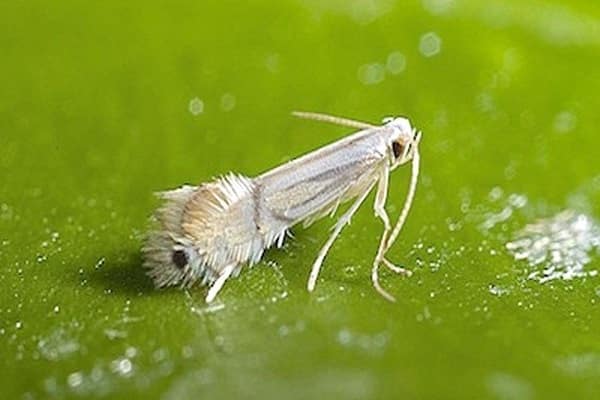
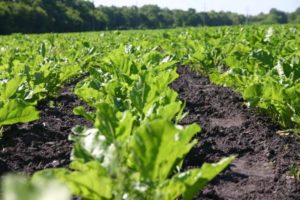


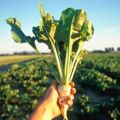
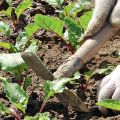
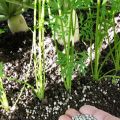

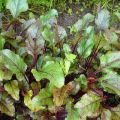
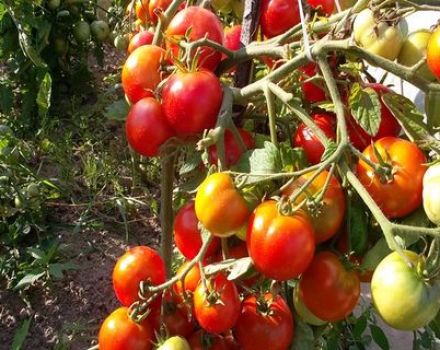

This problem most often occurs due to insufficient watering of seedlings. Use mineral fertilizers for recovery and be sure to adjust watering so that there are no such diseases in the future.